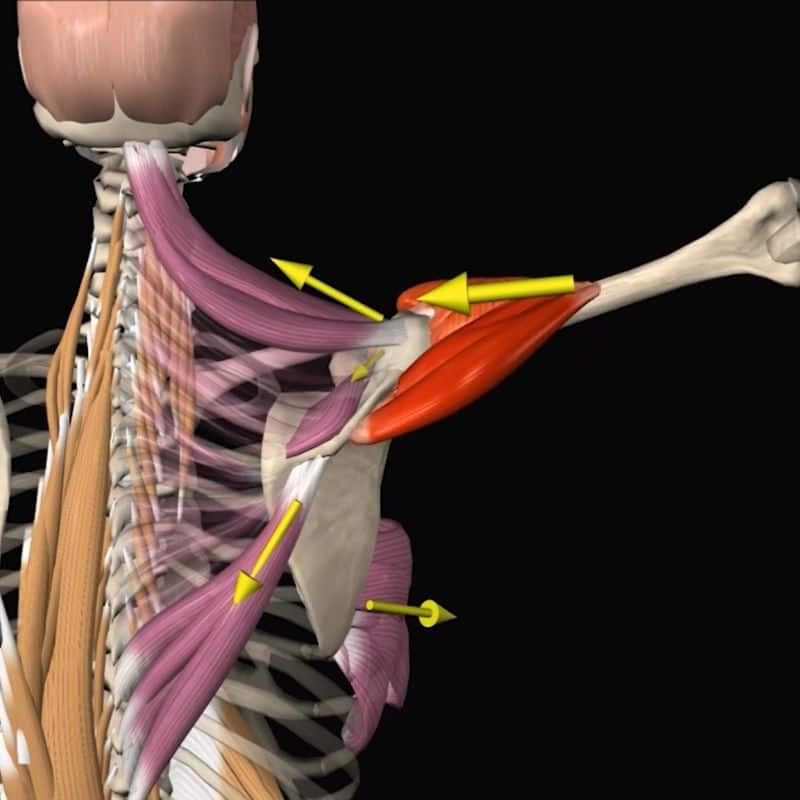The complete anatomical analysis of the Lateral Raise Exercise!
If you want to build up your shoulders, then this is just the exercise for you.
If you’re looking to develop well-rounded shoulders, then the lateral raise exercise is your go-to solution. This Muscle and Motion article delves into the anatomical analysis of the lateral raise exercise, highlighting the target muscles and providing detailed instructions for proper execution.
Which muscles will you strengthen with the the lateral raise exercise?
The shoulder muscle is made up of 3 heads – the anterior deltoid, the medial deltoid, and the posterior deltoid. The primary muscle worked in the lateral raise exercise is the medial or middle deltoid. By raising your arms to the sides, you effectively engage the middle deltoid muscle. It’s important to note that altering the direction of the arm lift can shift the emphasis to different deltoid heads. For instance, raising the arms to the front (aka Front Raise) primarily targets the anterior deltoids.
How to perform the lateral raise exercise
- Opt for a manageable weight: prioritize maintaining good form and performing repetitions correctly, rather than using excessive weight.
- Maintain an upright posture: stand or sit straight with your feet shoulder-width apart and hands down at your sides, palms facing inward.
- Gradually lift your arms: raise your arms slowly to the sides until they are parallel to the floor.
- Pause and lower your arms: hold the raised position briefly, then slowly lower your arms back down to your sides.
- Aim for optimal repetitions: strive to complete 8 to 12 repetitions, ensuring controlled and deliberate movements throughout.
Important considerations
To maximize the benefits of the lateral raise exercise and minimize the risk of a shoulder injury, keep the following in mind:
- Maintain a neutral back and engage your core throughout the exercise.
- Avoid relying on momentum: perform the arm movements in a controlled manner without swinging them forcefully. Momentum-based lifts engage different muscles and hinder the desired shoulder development.
Anatomy and variations of the lateral raise:
The posterior and anterior deltoids not only contribute to abduction but also stabilize the shoulder joint. During arm abduction, the upper trapezius, lower trapezius, and serratus anterior muscles collaborate to generate a scapular force couple, facilitating upward scapular rotation.

Here we can see the rotator cuff muscle colored in brown. The rotator cuff is a group of muscles in the shoulder connecting the upper arm to the scapula. The rotator cuff provides stability to the shoulder.
There are two types of shoulder abduction:
- Shoulder abduction in the frontal plane
In this variation, presented on the left side of the video, the arms lift straight up to the sides, aligning with the body’s midpoint.
- Shoulder abduction in the scapular plane
This movement, shown on the right side of the video, occurs at an angle of approximately 35 degrees forward from the frontal plane. The arms are still positioned to the side but slightly in front of the body.
Opting for shoulder abduction in the scapular plane provides a more natural range of motion and more significant arm elevation.
Using a cable vs. using a dumbbell
The lateral raise exercise can be performed using either dumbbells or a cable. However, it is important to note that there is a biomechanical distinction between using weights and utilizing a cable or a resistance band. The difference lies in the direction of the resistance that opposes the raised hand.
- Dumbbell
In the lateral dumbbell raise, the weight always pulls down. Therefore, the maximal resistance force is at the end of the movement (when your arm is 90 degrees to the body). When your arms are down, the weight doesn’t exert any rotational force on the arm. Click to watch the full exercise in our Strength Training App – Lateral Raises (Dumbbell)
- Cable
In the lateral cable raise, the maximal resistance is at the beginning of the movement when the arm is close to the body (the angle between the cable and the arm is 90 degrees). At the end of the movement, the cable’s resistance is low and, therefore, the end of the movement is the easiest part. Click to watch the full exercise win our Strength Training App – Lateral Raises (Cable)
Which should you choose?
According to a study conducted by Botton et al. in 2013, the two most effective exercises for targeting the mid-deltoid are the dumbbell lateral raise and the cable crossover lateral raise. It’s important to note that both exercises are equally beneficial, and there isn’t a definitive “best” one.
You can incorporate both exercises into your routine and reap the benefits from each of them. So feel free to switch between the two and enjoy both their advantages.
Incorporating the Strength Training App into your fitness journey will take your workouts to the next level.
Download now from any device and sign up for free to experience the effectiveness of training smarter and better!
Written by Uriah Turkel, Physical Therapist and Content Creator at Muscle and Motion.

